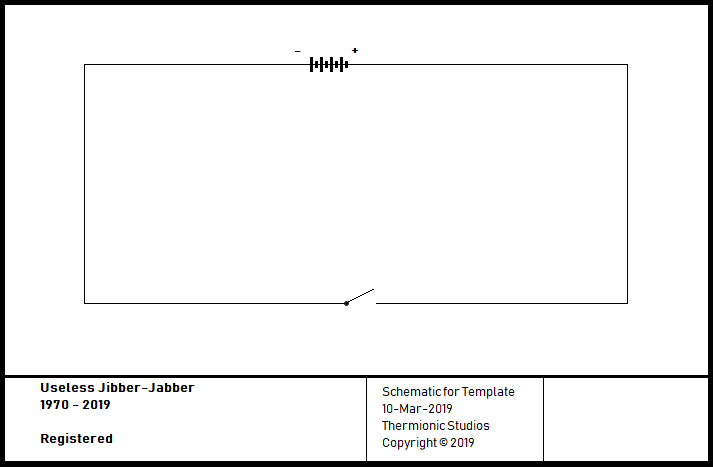Difference between revisions of "AstroSim"
| Line 25: | Line 25: | ||
===PCB Issue=== | ===PCB Issue=== | ||
| − | After running and checking the circuit on the PCB for building, we noticed that the output traces on the board have been printed in reverse: output 1 is actually output 2 per the schematic, and vice-versa. | + | After running and checking the circuit on the PCB for building, we noticed that the output traces on the board for the headphone jack have been printed in reverse: output 1 is actually output 2 per the schematic, and vice-versa. For all intents and purposes, it really doesn't matter since it's a mono signal that's coming from a common source: the output of IC1_B. |
| − | + | But studying the traces on the PCB against the schematic, and making notes in anticipation of the build, will be a new practice moving forward. | |
==Pedal Manual== | ==Pedal Manual== | ||
| Line 33: | Line 33: | ||
==Phase Inversion: Yes== | ==Phase Inversion: Yes== | ||
| − | + | First thing to note: IC1_A: Inverts signal. This original inversion is never truly undone by any subsequent active stages in the circuit. So this pedal inverts phase. Done. | |
| − | + | When we first got this and before we analyzed the circuit, we didn't expect this to invert phase. Upon inspection of the schematic we noticed that the very first gain stage inverts the signal, and then doesn't get corrected. | |
| − | |||
| − | |||
| − | + | ; "Well, what about IC2_B??", you say? | |
| − | + | ||
| + | Read on... | ||
| + | |||
| + | |||
| + | DeadAstronaut designed the use of IC2 (both A and B halves) specifically for the XLR output. An XLR output is called a "balanced output" as opposed to a standard instrument cable jack, which, because it is only a single signal, is called an "unbalanced output". The reason a balanced output, or cable was invented, is in order to reject line noise over long distances. The way a balanced line works is pretty much genius. What happens is that the two signals that are otherwise the same but each inverted from the other are put onto the cable. As the electrical signals pass through the cable, since they are traveling side-by-side, they will each pick up the same errant signals and noise. | ||
| + | |||
| + | ===The XLR Jack=== | ||
| + | Here's where the magic of a "balanced" cable now gets put into play. On the receiving side: the console, or mic preamp, or whatever is receiving a balanced line as an input will take both of those signals and invert one of them again. The balanced cable was intentionally designed this way. Using the zero-sum effect of combining two signals that are phased 180-degrees opposite of each other, any errant signals or line noise will now also have its phase inverted. When the two musical signals which have now been put back into phase are mixed back together again, the errant signals and other line noise (not intended) have now had their phases reversed and therefore get mixed together out-of-phase. The two out-of-phase signals of the errant noise then cancel each other out, thereby rendering a clean signal once again. | ||
| + | |||
| + | This is why XLR cables can be found in much longer lengths. They've been engineered to use the property of phase cancellation to "disappear" unwanted line noise and other possible signals that the line may be otherwise picking up. | ||
{| class="wikitable" style="left; margin-right:20px; background-color:#eeffee;" cellpadding="10" | {| class="wikitable" style="left; margin-right:20px; background-color:#eeffee;" cellpadding="10" | ||
Revision as of 16:05, 16 March 2021
DeadAstronautFX Astro-Sim Cabinet Simulator. Background information - cultural elements.
- Thermionic Studios is building two(2) AstroSim cabinet simulators. They will be available for rental once completed.
Controls

- Switch 1 - "Gain": Switches between three different gain settings, left to right: Bright, Dark, and Middle.
- Switch 2 - "Vintage/Modern": Switches the the sound of the output between a vintage or a modern speaker cabinet.
- Knob 1 - "XLR Vol": Adjusts the volume going to the XLR-out jack with fully clockwise being full volume.
- Knob 2 - "Hi": Adjusts the high or treble frequencies.
- Knob 3 - "Air": Never really had a control like this. It sounds like it focuses (clockwise) or muddies the output sound.
- Footswitch 1 - "On/Off": This footswitch toggles the pedal between engaged/active ("On"), and bypassed ("Off")
Bypass: True
The DeadAstronaut AstroSim is a true bypass effect.
General Information
This has been built into a pedal, but this may well have been the overlooking of the function of a cab sim since DeadAstronaut has been building pedals prior to building this "effect". The true benefit of such an effect is to be able to plug an instrument signal chain directly into a mixing console instead of pulling out an amp and mic'ing it up. A cabinet simulator can make all of that set up irrelevant if you know that the cab sim is the kind of tone you're looking for. But, if this "effect" is the last piece of equipment before plugging directly into a soundboard, then the question still stands if this effect shouldn't be on a pedalboard but sitting instead on a console or computer recording interface.
The other thing that you'll notice, especially with DeadAstronaut's current build manual: the PCB was designed to be housed in a smaller 1590B-sized enclosure. However, in order to accommodate the XLR output jack, DeadAstronaut's manual shows the PCB sitting inside a larger 1590BB-style enclosure. If you can forego the XLR out, building this in a 1590 is perfectly acceptable. We're currently working on seeing if a 125b / 1590N1 enclosure will be able to house both the PCB and the XLR output jack despite the all-around smaller size.
PCB Issue
After running and checking the circuit on the PCB for building, we noticed that the output traces on the board for the headphone jack have been printed in reverse: output 1 is actually output 2 per the schematic, and vice-versa. For all intents and purposes, it really doesn't matter since it's a mono signal that's coming from a common source: the output of IC1_B.
But studying the traces on the PCB against the schematic, and making notes in anticipation of the build, will be a new practice moving forward.
Pedal Manual
Phase Inversion: Yes
First thing to note: IC1_A: Inverts signal. This original inversion is never truly undone by any subsequent active stages in the circuit. So this pedal inverts phase. Done.
When we first got this and before we analyzed the circuit, we didn't expect this to invert phase. Upon inspection of the schematic we noticed that the very first gain stage inverts the signal, and then doesn't get corrected.
- "Well, what about IC2_B??", you say?
Read on...
DeadAstronaut designed the use of IC2 (both A and B halves) specifically for the XLR output. An XLR output is called a "balanced output" as opposed to a standard instrument cable jack, which, because it is only a single signal, is called an "unbalanced output". The reason a balanced output, or cable was invented, is in order to reject line noise over long distances. The way a balanced line works is pretty much genius. What happens is that the two signals that are otherwise the same but each inverted from the other are put onto the cable. As the electrical signals pass through the cable, since they are traveling side-by-side, they will each pick up the same errant signals and noise.
The XLR Jack
Here's where the magic of a "balanced" cable now gets put into play. On the receiving side: the console, or mic preamp, or whatever is receiving a balanced line as an input will take both of those signals and invert one of them again. The balanced cable was intentionally designed this way. Using the zero-sum effect of combining two signals that are phased 180-degrees opposite of each other, any errant signals or line noise will now also have its phase inverted. When the two musical signals which have now been put back into phase are mixed back together again, the errant signals and other line noise (not intended) have now had their phases reversed and therefore get mixed together out-of-phase. The two out-of-phase signals of the errant noise then cancel each other out, thereby rendering a clean signal once again.
This is why XLR cables can be found in much longer lengths. They've been engineered to use the property of phase cancellation to "disappear" unwanted line noise and other possible signals that the line may be otherwise picking up.
| Schematic ID | Electronic Part | Action | Phase State |
|---|---|---|---|
| IC1_A | NE5532 | Inverts | Inverted |
| IC1_B | NE5532 | Non-Inverting | Inverted |
| IC2_A | NE5532 | Non-Inverting | Inverted |
| IC2_B | NE5532 | Inverts | Original |
Schematic
Artists
We are currently unaware of any artists actively using the pedal now, or who have in the past.
- Additional Sources
